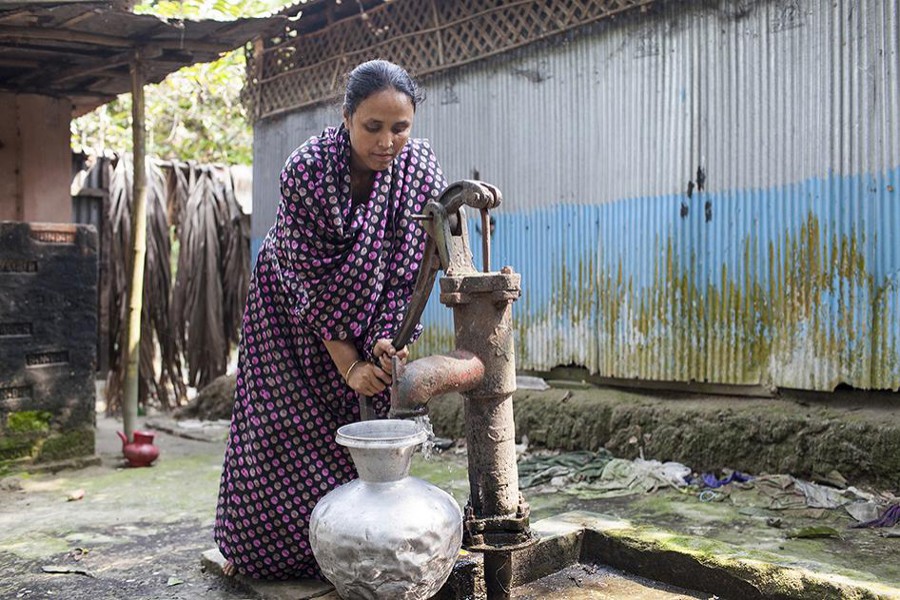
Published :
Updated :

Clean drinking water and healthy sanitation are essential for health. Bangladesh has ensured 87 per cent people's access to safe water and 61 per cent's access to improved sanitation. The government of Bangladesh also succeeded in reducing the rate of open defecation from 42 per cent to 1.15 per cent within 12 years with cooperation from NGOs (non-government organizations. On the other hand, 13 per cent people do not have access to clean drinking water. According to UNICEF 2015, "Over 66 million people don't have access to improved sanitation in Bangladesh - 38% of the population." The World Health Organisation (WHO) estimates that 97 per cent of the people in Bangladesh have access to water and only 40 per cent have healthy sanitation. With a staggering 60 per cent of the population that use unsafe drinking water, the nation is in danger. UNICEF Executive Director Anthony Lake said, "Safe water, effective sanitation and hygiene are critical to the health of every child and every community - and thus are essential to building stronger, healthier, and more equitable societies." Every year many people have lost their lives due to poor water facilities and unhealthy sanitation. Poor sanitation and contaminated water are also linked to transmission of diseases such as cholera, dysentery, hepatitis A, and hepatitis B. According to WASH Watch 2017, "Around 289,000 children under five die every year from diarrheal diseases caused by poor water and sanitation facilities in the whole world. That's almost 800 children per day or one child every two minutes." According to WHO, "every minute a newborn baby dies from infection caused by a lack of clean water and an unclean environment." The ratio of death rate due to water-borne diseases is high in developing countries rather than developed countries. Bangladesh is not out of this calculation of death due to poor sanitation and use of contaminant water. According to Water aid 2017, "2,000 children less than five years old die from diarrheal diseases caused by poor water and sanitation in Bangladesh."
For sustainable development the government needs to ensure affordable and sustainable management of water and access to sanitation for all because health is a part of fundamental human rights. The ongoing sustainable development agenda also focus on ensuring safe drinking water and sound sanitation for all in the world. The Sustainable Development Goal (SDG) 6 envisages clean water and sanitation for all. It has two targets. One is to achieve universal and equitable access to safe water and sanitation for all by 2030. Another is access to adequate and equitable sanitation and hygiene for all and an end to open defecation. To this end, special attention will be paid to the needs of women and girls and those in vulnerable situations.
The government of Bangladesh has a target to meet successfully all goals of the sustainable development agenda by 2030. In Bangladesh 87 per cent and 61 per cent people have access to clean water and healthy sanitation facilities respectively, which is good news for us. As far as the SDG 6 is concerned, Bangladesh focuses on clean water and sanitation. If Bangladesh wants to achieve progress in ensuring clean drinking water and safe sanitation in all villages of the country, the government has to take 'Maria village' as a model for that. The 'Maria village' is a success story in ensuring hundred per cent access to clean water facilities and safe sanitation in the country. A densely-populated area in Shahjahanpur Upzila of Bogra, the 'Maria village' is situated on the bank of the river Korotoa. This scribe went to the 'Maria village' for the field study on 'clean water and sanitation' under the Development Studies Department of Dhaka University. In the village' around 90 per cent people are dependent on agriculture and every family of the village has graduated from poverty. Every family has sustainable economic stability and every family is also aware about health of their family members. They have access to clean water facilities and safe sanitation. The government, BRAC, Rural Development Academy of Bogra and other NGOs have succeeded in ensuring full drinking water and safe sanitation coverage by creating awareness about these necessities.
To achieve the SDG 6 the 'Maria village' is a perfect model to follow by other villages in the country. The government and NGOs need to take more steps for bringing other villages also under the full coverage of safe sanitation and pure drinking water so that the country can attain the SDG 6 by 2030.
Email: [email protected]


 For all latest news, follow The Financial Express Google News channel.
For all latest news, follow The Financial Express Google News channel.